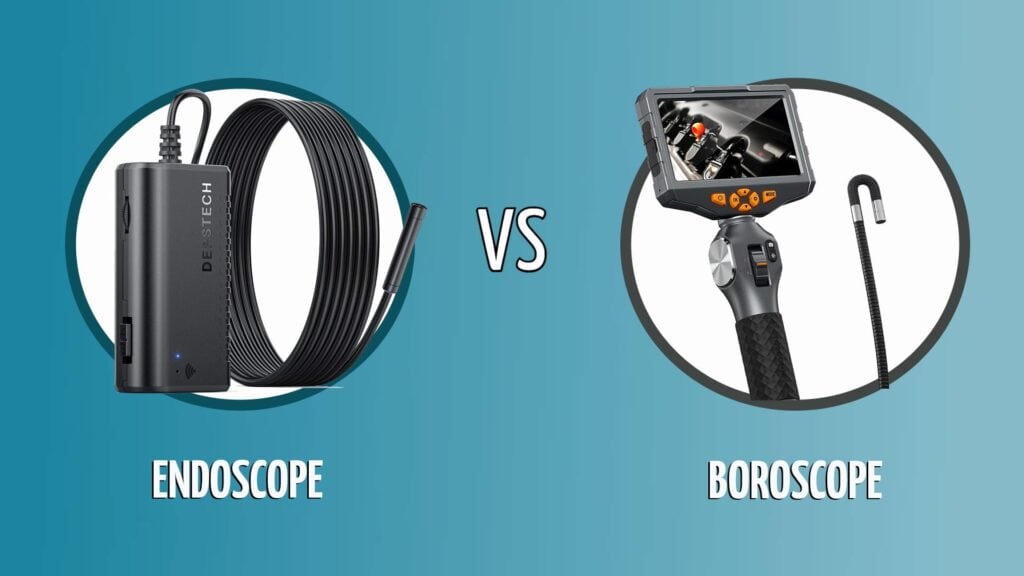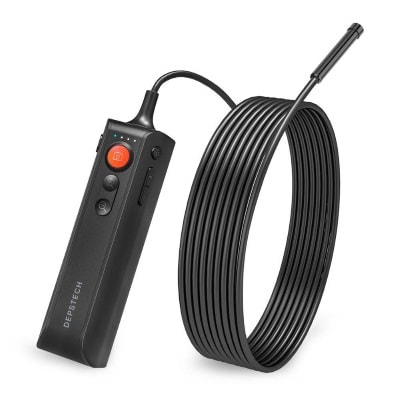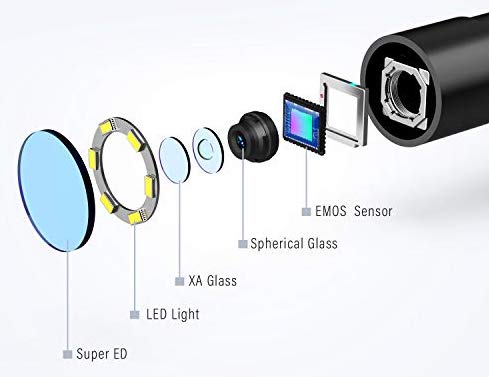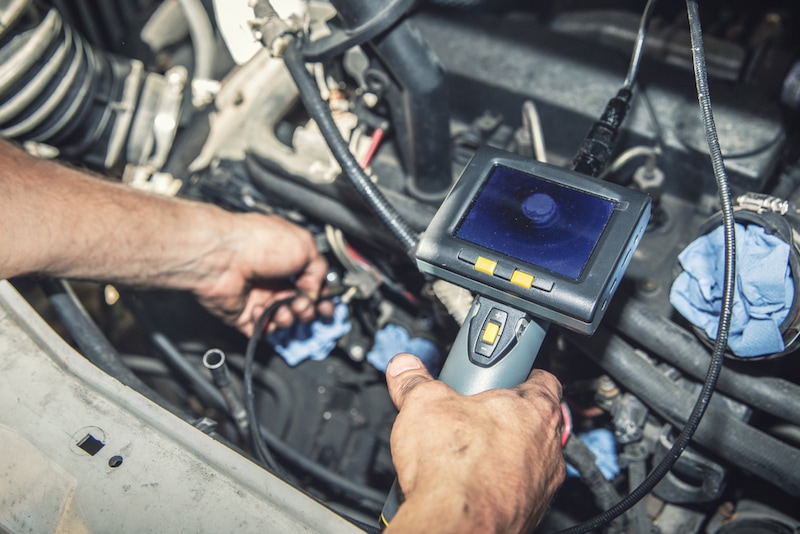Endoscope vs Borescope: What’s the Difference?
Last Updated on

When looking for a borescope, you might find quite a few endoscopes listed and wonder if you could use one of those instead. What is the difference between these two very similar-looking tools?
Though they may look like the same device, there are several important differences between these two useful tools. If you get the wrong one, it might not work for your intended use.
Let’s break into the differences between endoscopes and borescopes including differences in how they’re built, how they’re used, and more. They might seem similar, but we want to make sure that you never confuse the two.
What is an Endoscope?
An endoscope technically is a type of borescope, though not all borescopes are endoscopes. Endoscopes are much more refined and precise versions of borescopes. They perform the same types of tasks, but in a much higher-risk area with no room for error.

While borescopes are commonly employed in mechanical objects, endoscopes perform their jobs on living specimens. Whenever a surgeon needs to be able to see inside of the body to get a more detailed glimpse at what’s going on, they use an endoscope.
The Endoscopic Camera
In essence, an endoscope is a very tiny camera that’s attached to a long, flexible cable. This cable allows you to maneuver the camera inside of the tightest and least forgiving spaces imaginable.
Once in these spaces, endoscopes provide enough light to illuminate the area but not blind the camera since inside the human body bright lights won’t work as well.
Endoscope Overview
Applications
Endoscopes have a variety of uses inside the medical community. They’re often used for diagnosing medical issues by allowing surgeons to get a closer look at what’s going on inside the body.
They’re also used frequently during surgery so that the surgeons can see what they’re doing. They have to make very tiny, precise movements and cuts inside of someone’s body, and the endoscope is what makes that possible. Most endoscope cameras are 1080HD with extremely advanced optics.

Most commonly, they’re used for endoscopies, the procedure from which the endoscope takes its name. Here, they’ll send the endoscope through your mouth and into your digestive tract for examination. They can also insert it through your other end, which is called a colonoscopy.
Field of View
Endoscopes tend to have a smaller field of view than borescopes so they can get a very detailed look at a small part of the body. Generally, the field of view on an endoscope is just 90 degrees.
Maneuverability
Endoscopes have to navigate the maze of microscopic passages that exist inside the body. To do this, they need excellent maneuverability. For this reason, endoscopes are generally extremely flexible.
Some of the best endoscopes feature a mechanical head that can be turned and controlled by the surgeon. This helps to maneuver the endoscope into even harder-to-reach areas since you have the ability to manipulate the tip of the endoscope to help navigate turns and other obstacles.
Lights
Endoscopes don’t need very bright lights. Inside the body, low levels of light work best, or the camera will get washed out and the surgeons won’t be able to see anything. As such, the lights equipped on endoscopes are generally rather mild, nowhere near as strong as the bright light settings on borescopes.

Price
Medical grade equipment is never cheap and the endoscope is one of the higher-end, more pricey pieces of medical gear. These precise tools can be radically expensive and generally cost many times what a borescope does.
Pros & Cons of Endoscopes
- Very maneuverable, may even have a controllable head
- Softer lights work better in the body
- Wildly expensive
- Field of view is only 90 degrees
What is a Borescope?
When workers in many different professions need to see the inside of something narrow and hard to reach, they enlist the help of a borescope. This tool allows you to see inside of a small, poorly lit place that you could normally never reach.

Today, most borescopes are cameras with high-definition capabilities so you can see the inside of whatever you’re working on with absolute clarity and detail. They also have lights built-in so that they can illuminate any dark spaces, providing you an unfettered view of your work.
But borescopes aren’t just a modern invention. They’ve been used for quite a while! As far back as World War II, they were used for examining the insides of large guns.
Of course, these were very different borescopes than what you most commonly see today. These were rigid borescopes, and there was no camera technology. You’ll still see these in use, but they’re not as common now as the camera-toting variety.
Borescope Overview
Applications
The borescope is used in a variety of applications in order to see inside of many different items. Mechanics of all types use borescopes to inspect the insides of engines, cylinder heads, and other parts that are difficult to see under normal circumstances. These are used by car mechanics, aviation mechanics, and even aerospace technicians.

Field of View
Borescopes are also used by your local plumber. If they’ve got a blockage that seems to deter their best efforts at removing it, then they have to get in there and see what’s going on. They can’t climb into the pipe (and who would want to do that anyway?) so they send a camera in instead. This gives them a good view of what’s going on inside your pipes; a place that’s hard to reach and would normally get you filthy!
But borescopes’ usefulness doesn’t end there. They’re used in gunsmithing for inspecting the insides of guns and barrels. They’re also used in law-enforcement forensics departments. And they’re used by just about every profession that deals with engines.

The field of view refers to how wide of an area you can see when viewing through your borescope. It’s expressed in degrees.
Most borescopes have a field of view of about 120 degrees. This allows you to inspect a wide area all at once for a complete picture of what you’re looking at.
Maneuverability
Borescopes are pretty maneuverable so they can be fed into difficult to reach areas with relative ease. But they’re not nearly as flexible as endoscopes that have to make much more refined movements. Because of this, borescopes aren’t as easy to work with, especially when navigating tight spaces.
Price
Borescopes can get pretty pricey, but on the lower side of the spectrum, they’re actually quite affordable. Even video borescopes have come down in price so much that they’re within the budget of most professionals and hobbyists alike.
Pros & Cons of Borescopes
- Bright light settings help to see your subject
- Affordably priced
- 120-degree field of view
- Lack of flexibility makes it more difficult to maneuver
Endoscope vs Borescope: Which Has the Advantage?
At the end of the day, endoscopes and borescopes are very similar tools for different purposes. To suit their purposes, each tool has some slight differences that make them better for their intended uses.| Aspect | Which Has the Advantage? |
|---|---|
| Maneuverability | Endoscope |
| Diameter | Endoscope |
| Lighting | Borescope |
| Field of View | Borescope |
| Level of Detail | Endoscope |
| Price | Borescope |
Maneuverability
Endoscopes are more maneuverable than borescopes. They have to make their way through tighter spaces and the cost of making a mistake is incredibly high. Sometimes, they even have heads that can be controlled remotely to allow the endoscope to make turns and more.
Diameter
Endoscopes tend to be thinner than borescopes, which makes sense, given the invasive nature of medicine. Endoscopes need to reach some pretty tight places! Borescopes also tend to be less flexible since they aren’t generally used in such difficult places.

Lighting
Borescopes have much brighter lights than endoscopes though. This is to illuminate the inside of machinery, plumbing, or other places where no light can enter. The bright light is needed to get a clear picture of the inside. But the human body doesn’t do as well with bright lights; they tend to wash out the camera. So endoscopes employ softer lights that make it easier to see inside the body.
Field of View
You’ll see more of what you’re looking at with a borescope. They usually have a very wide field of view; about 120 degrees is normal. This gives you a nice large image of a big area. But endoscopes are more precise. They have a field of view of about 90 degrees, which allows you to see less at once.
Level of Detail
Endoscopes provide a more detailed view of a smaller area, which is perfect for surgeons.
Price
One of the most notable differences between these two devices is the price. Because they’re made to work with many different professions, borescopes are generally pretty affordable. They can get expensive on the high-end, but some of the more affordable models will fit into the average hobbyists budget. But that’s not the case with endoscopes. These are medical-grade tools and the cost reflects that. Even the more affordable ones are rather costly and the high-end ones used in hospitals can be astronomically expensive.
Conclusion: Endoscope vs Boroscope
In the end, the borescope and endoscope are very similar tools that function quite similarly but are used for drastically different purposes. As such, they have notable differences between them to help perform their designated functions.
Borescopes are a tool that’s used by many professionals. They’re versatile and affordable. With a borescope, you can see clearly into spaces that you could normally never reach and that might be too dark to see if you could. You’ll find them being used by mechanics, plumbers, and more.
Endoscopes are used only by the medical profession. They’re a very precise and expensive instrument that’s meant for use inside of the body. While borescopes let you see inside machinery, endoscopes do the same inside of the body. They are incredibly precise tools with sky-high price tags.
In most cases, you’ll probably want to choose the borescope. Only for medical purposes should the endoscope be used; particularly for surgery.
About the Author Robert Sparks
Robert’s obsession with all things optical started early in life, when his optician father would bring home prototypes for Robert to play with. Nowadays, Robert is dedicated to helping others find the right optics for their needs. His hobbies include astronomy, astrophysics, and model building. Originally from Newark, NJ, he resides in Santa Fe, New Mexico, where the nighttime skies are filled with glittering stars.
Related Articles:
How to Clean a Refractor Telescope: Step-by-Step Guide
How to Clean a Telescope Eyepiece: Step-by-Step Guide
How to Clean a Rifle Scope: 8 Expert Tips
Monocular vs Telescope: Differences Explained (With Pictures)
What Is a Monocular Used For? 8 Common Functions
How to Clean a Telescope Mirror: 8 Expert Tips
Brightfield vs Phase Contrast Microscopy: The Differences Explained
SkyCamHD Drone Review: Pros, Cons, FAQ, & Verdict

